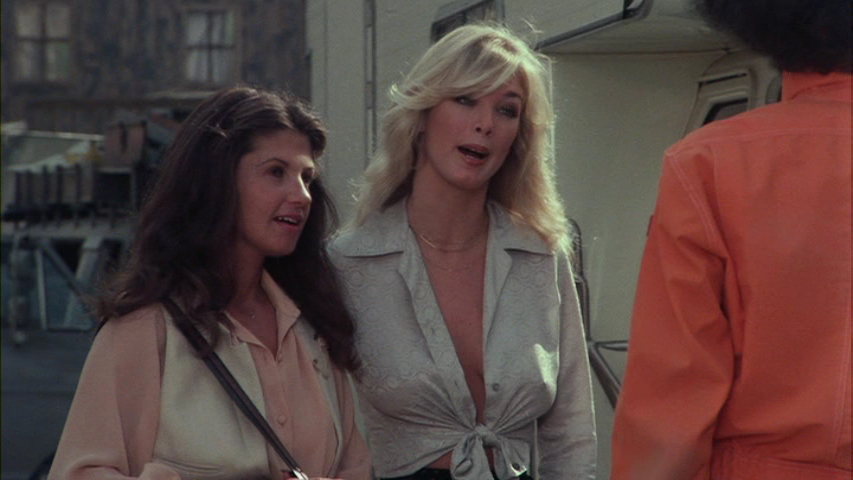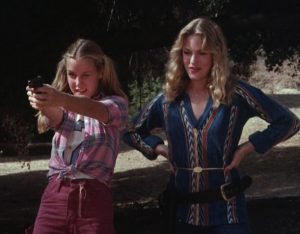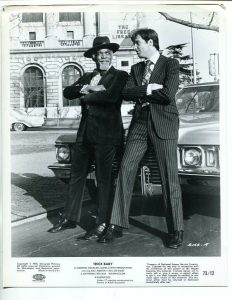I once almost wrote a musical like Angels’ Brigade (1979).
I was in the midst of my most successful fringe tour in the summer of 1997, with a show called Sorority Girls Slumber Party Massacre: The Musical. Everywhere we went we were doing boffo box office and I was starting to ask myself “How am I going to follow this?” I had a cast of regulars, mostly female, with whom I was hoping to work again. And I had a certain style, or “brand” as some people might say. I needed an idea that would not only appeal to me, but to the fans of my current and previous shows. After a couple of all night drives down the Trans Canada Highway, I started to think about movies like Angels’ Brigade and how they might just be the perfect fodder for my next musical atrocity. But perhaps I need to back up a little…
When I was at university, I majored in FIlm Studies. There was one class in filmmaking, and another in screenwriting, but most of our time was spent studying films, the way English majors study literature. This was not entirely satisfying to an aspiring writer and filmmaker like me. Fortunately, I also did a minor in Theatre, where most of our time was spent acting, directing, stage managing, building sets, etc. I also had the opportunity to write plays.
The Black Hole Theatre Company, my alma mater’s student run theatre company, accepted submissions of new plays by student writers for possible production. I was excited by the possibility of having a play produced, but I learned very quickly that if I wanted my play to be chosen it had to have a lot of good roles for women.
It didn’t take a genius to notice that there were twice as many women enrolled in theatre as men. And most classic plays, from Shakespeare to Arthur Miller, had way more parts for men than women. The Black Hole Theatre Company, my professor told me, made a point of trying to select plays that had good roles for women. I took this news to heart and wrote a play for three women and two men. It was produced as part of the The Black Hole Theatre Company’s Lunch B.H.A.G.G. series (free plays produced at lunch time).
When I started producing my own plays, at the Winnipeg Fringe Festival, there were no requirements to cast women. But I felt that it was stupid to write a lot of parts for men, when there were clearly more women interested in being in plays. And from a practical point of view, I knew that I had access to lot of good female actors (friends and acquaintances from university). There were already enough plays filled with parts for men, and not enough good men to fill them. So, I wrote plays with more parts for women.
This culminated with my first musical, Bad Girls Jailhouse in 1994. My previous plays had all included one man – and I toyed with the idea of having a male guard, or warden – but in the end I wrote a play for seven women. Yes, seven women. Smarter people than me were producing one person shows, in which they stood on a bare stage and talked for an hour (like a stand up comedian). I was producing a musical with props and costumes. And seven actresses. Apparently I wasn’t concerned about making a profit.
Two years later, I took Bad Girls Jailhouse on the road. It was my first fringe tour, and it was a success. But nothing could have prepared me for the success of Sorority Girls Slumber Party Massacre: The Musical in 1997, and then later in 2001. It sold out performances and broke box office records. It was a play that featured four women and one man.
Both Bad Girls Jailhouse and Sorority Girls Slumber Party Massacre: The Musical. were satires of film genres. I had always imagined that I would be writing and directing films. But in the pre digital video, pre internet days of my early career, making films was expensive! Even if I had made a short three minute movie, it would have cost me hundreds of dollars and I would have never made that money back. For the same amount of money (or less), I could write a one hour (or ninety minute) play and produce it at the fringe festival. And wonder of wonders, the plays could actually make a profit!
But being a film fan, and a filmmaker at heart, I chose to write plays that were kind of like movies. My specialty became musical spoofs of film genres. Mel Brooks was one of my heroes. He taught me, among other things, that the best satire is a labor of love. He often included musical numbers in his films, which were always a highlight. I saw myself doing things that Mel might have, but with more unusual, or perhaps less respected film genres. So, after the success of Sorority Girls Slumber Party Massacre: The Musical, I was looking for another offbeat film genre I could lovingly satirize. One that involved a large proportion of female characters…
And that’s what made me think of films like Angels’ Brigade and The Doll Squad (1973). I don’t know if there’s an official name for that subgenre of cinema, but someone I know once referred to them as “female commando movies.” Interestingly, some say that The Doll Squad was the inspiration for Charlie’s Angels (1976-81). Angels’ Brigade was clearly named to cash in on the success of that show, which was at the height of it’s popularity. I wouldn’t call Charlie’s Angels “female commandos”, so that may be a misnomer. I’ll have to come up with a better term for them…
In any case, I thought that a musical about a team of female agents/detectives/vigilantes sounded like a really fine idea back in 1997. Unfortunately, that never happened. But it did give me an excuse to revisit movies like this one…
Angels’ Brigade aka Angels’ Revenge aka Seven from Heaven (1979) is undoubtedly a bad movie. It scores a 2.0 on the IMDb, which is lower than a lot of movies that aren’t worth anyone’s time. But Angels’ Brigade is the kind of “bad” that can be a whole lot of fun to watch (if you have a taste for it). The assembling of the team, and the explanation of each member’s purpose, is almost as hilarious as the brilliant SCTV sketch Maudlin’s Eleven (1982). For example, they need someone to distract the guards at the front gate of an isolated drug processing compound, so they bring in a beautiful model played by Noela Velasco, whose only other credit is an episode of Chico and the Man (1974–1978).
But they are ALL beautiful women, including Susan Kiger, a former Playboy playmate. I don’t think they needed to go outside the group of six to find a woman who could distract a couple of guards. But much like Maudlin needed his team to add up to eleven (and so brought in The Harmonica Gang to wait by a pay phone), Angel – wait, there is no Angel – April, a schoolteacher played by Jacqulin Cole, needs her team to add up to seven – as in “seven from heaven”, so she’s got to have a professional beautiful woman to walk up to those guards and bat her eyelashes. Makes sense to me.

Schoolteacher April (Jacqulin Cole, real life wife of director Greydon Clark) and Las Vegas entertainer Michelle (real life Playboy playmate Susan Kiger) recruiting stuntwoman Terry (Sylvia Anderson).
Oh, and in case you haven’t figured it out, this is #NotQuiteClassicCinema gold. It’s the kind of movie magic that makes sifting through bargain bins of unwanted VHS tapes worth it. Or in my case, watching random movies on TV late at night.
The man responsible for Angels’ Brigade is Greydon Clark, the auteur of such #NotQuiteClassicCinema greats as Black Shampoo (1976), Satan’s Cheerleaders (1977), Without Warning (1980), and Joysticks (1983) – all of which are in my personal library. Apparently he first conceived of Angels’ Brigade as a blaxploitation picture (not unlike Black Shampoo), but in the end he went with a multicultural team of women that included Sylvia Anderson, as the 6’1″ tall stuntwoman, and Lieu Chinh as the shorter martial arts expert. Here they are sandwiched in between the schoolteacher and the beautiful model:

The seven from heaven are rounded out by real life sisters Robin and Liza Greer. They are two of the women who tell their stories in the book You’ll Never Make Love in This Town Again (1995), which appears to be an expose of prostitution and sex with celebrities in Hollywood.

Real life sisters Robin and Liza Greer in Angels’ Brigade.

One of the most remarkable things about Angels’ Brigade is its star-studded supporting cast. When I first stumbled upon this movie on late TV, one of the reasons that I couldn’t stop watching it was that every few minutes another recognizable TV actor would make an appearance. The movie seemed to be, to my relatively untrained eyes, extraordinarily bad – but all of these famous actors were in it! How could that be?
Top of the list for me was Jack Palance, who I used to see on Ripley’s Believe It or Not! (1982-86) and in movies. Perhaps even more shocking to me was the presence of Jim Backus and Alan Hale Jr. – both from Gilligan’s Island (1964-67) which I had watched religiously in reruns. Other recognizable faces included: Peter Lawford, Neville Brand,, Pat Buttram, and Arthur Godfrey. I didn’t recognize Darby Hinton at the time, but I would get to know him later thanks to the mighty Malibu Express (1985).
As a kid, I knew nothing about the common exploitation filmmaking technique of hiring recognizable “names”, or actors with name recognition, paying them for one day of work and then putting their names and/or faces on your poster, in your trailer, etc. Often they would be actors who used to be successful, but had fallen on hard times. I’m not saying that this was the case for any of the people in Angels’ Brigade, but according to the cinematographer, Peter Lawford would show up drunk with a woman on each arm, and perform his scenes sitting in a chair because he had trouble standing.
I could go on about Angels’ Brigade all day, but I’ve probably already written more words than could be reasonable justified. Don’t get me wrong, I love it. Nostalgia is undoubtedly a factor, but it also a camp classic – a minor masterpiece of #NotQuiteClassicCinema – and I could happily watch it on any given #FridayNightAtTheHomeDriveIn.
 When we first meet ‘Folks and Blue (played by Kiel Martin and Mel Stewart), they are in the midst or ripping someone off. But we are instantly sympathetic to them, because the person they are ripping off is a bad guy (racist, selfish – and in fact he believes that he is ripping off Blue). So, in a sense, the ‘victim’ of the con is getting exactly what he deserves. Not to mention that we can admire the skill, intelligence, and charisma that ‘Folks and Blue possess. They may technically be criminals, but they are kind of like Robin Hood (stealing from rich racists and giving to the poor – namely themselves).
When we first meet ‘Folks and Blue (played by Kiel Martin and Mel Stewart), they are in the midst or ripping someone off. But we are instantly sympathetic to them, because the person they are ripping off is a bad guy (racist, selfish – and in fact he believes that he is ripping off Blue). So, in a sense, the ‘victim’ of the con is getting exactly what he deserves. Not to mention that we can admire the skill, intelligence, and charisma that ‘Folks and Blue possess. They may technically be criminals, but they are kind of like Robin Hood (stealing from rich racists and giving to the poor – namely themselves).






